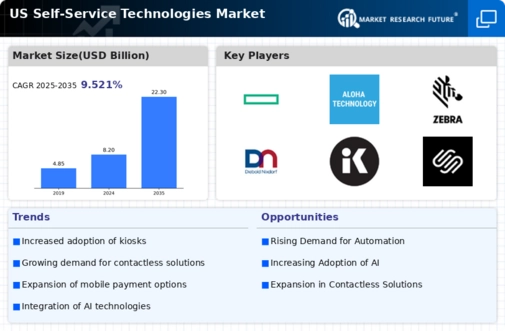Shift Towards Digital Transactions
The self service-technologies market is witnessing a significant shift towards digital transactions, driven by consumer preferences for seamless payment experiences. With the rise of e-commerce and mobile payment solutions, businesses are increasingly adopting self-service technologies that facilitate digital transactions. Data indicates that over 60% of consumers prefer using digital payment methods, such as mobile wallets and contactless cards, for their purchases. This trend is prompting retailers and service providers to invest in self-service kiosks equipped with advanced payment systems. As a result, the self service-technologies market is likely to expand, as businesses seek to enhance customer convenience and streamline payment processes.
Increased Focus on Health and Safety
In the self service-technologies market, there is an increasing focus on health and safety, particularly in public spaces. Businesses are adopting self-service solutions to minimize physical contact and enhance hygiene standards. For example, touchless kiosks and mobile ordering systems are being implemented in restaurants and retail environments to reduce the risk of contamination. This trend is supported by consumer sentiment, with surveys indicating that approximately 75% of individuals prioritize health and safety when choosing service options. Consequently, the self service-technologies market is likely to see a rise in demand for solutions that promote safe interactions, as businesses adapt to evolving consumer expectations.
Rising Consumer Demand for Convenience
The self service-technologies market is experiencing a notable surge in consumer demand for convenience. As lifestyles become increasingly fast-paced, individuals seek solutions that minimize time spent on routine tasks. This trend is particularly evident in sectors such as retail and hospitality, where self-service kiosks and mobile applications are gaining traction. According to recent data, approximately 70% of consumers express a preference for self-service options when available. This shift not only enhances customer satisfaction but also allows businesses to streamline operations, thereby reducing labor costs. The self service-technologies market is thus positioned to benefit from this growing consumer inclination towards convenience, as companies invest in innovative solutions to meet these evolving expectations.
Technological Advancements in Automation
Technological advancements play a pivotal role in shaping the self service-technologies market. Innovations in automation, such as artificial intelligence and machine learning, are enhancing the functionality and efficiency of self-service solutions. For instance, AI-driven chatbots are increasingly utilized in customer service applications, providing instant responses and improving user experience. The market for AI in self service technologies is projected to reach $5 billion by 2026, indicating a robust growth trajectory. These advancements not only improve operational efficiency but also enable businesses to offer personalized experiences to customers. Consequently, the self service-technologies market is likely to witness accelerated adoption of automated solutions, driven by the need for enhanced service delivery and operational cost reduction.
Growing Investment in Self-Service Infrastructure
Investment in self-service infrastructure is a key driver of growth in the self service-technologies market. Businesses are increasingly recognizing the value of self-service solutions in enhancing operational efficiency and customer engagement. According to industry reports, investments in self-service technologies are expected to exceed $10 billion by 2027, reflecting a strong commitment to modernization. This influx of capital is facilitating the development of advanced self-service kiosks, mobile applications, and automated customer service platforms. As a result, the self service-technologies market is poised for expansion, as companies leverage these investments to improve service delivery and meet the evolving needs of consumers.























Leave a Comment